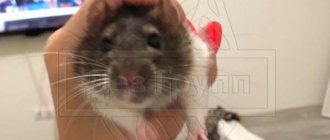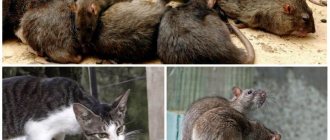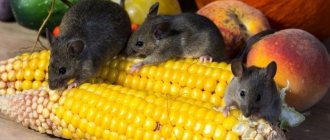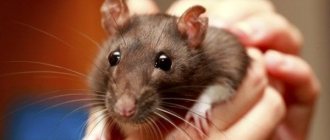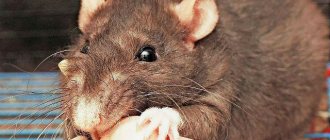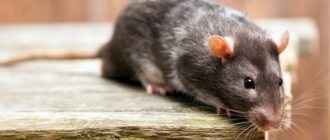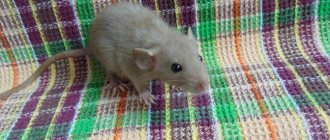- Wild animals
- >>
- Mammals
The Gambian rat is one of the largest species in the rodent family, but also one of the friendliest. Due to the large size of Gambian rats, they pose a serious threat to native species (especially nesting species) and crops, especially if they invade mainland Florida.
Origin of the species and description
Photo: Gambian rat
Gambian rats are found in central Africa, in areas south of the Sahara Desert and as far south as Zululand. This includes countries like Nigeria and others.
Gambian rats are burrowing animals. They prefer cool, dry and dark places to place their burrows as they are sensitive to heat. In their native range in Nigeria, Gambian rats are found in degraded forests, forest clearings and edges, coastal areas and sometimes near human habitations. Burrows are built near the roots of large trees, especially oil palms and the stumps of dead trees. They also inhabit areas near termite mounds, probably because these areas remain dry and cool during the rainy season.
Video: Gambian rat
This species is very common in the natural habitat of the Grassy Key area. They do not appear to live in wet scrubland or mangrove areas. They have also been reported in modified and developed residential areas. They may not need to create their own burrows in the Florida Keys, since limestone formations, trees, human habitations and trash piles are good substitutes.
The Gambian rat, also called the African giant rat, is one of the largest rats in the mouse family with an average length of about 1 m, including the tail. The Gambian rat can weigh up to 4 kg, which is comparable to a small domestic cat.
Habitat
Gumby rats live on the African mainland. They can be found in different parts of the continent, from the Sahara Desert to the “Land of the Zulu”. They live in different areas. Rats are found in arid desert areas. A colony of rodents can move across the African savanna. But most of all, mammals prefer forest areas with a moderate, cool climate.
This is interesting! Gambian rats can climb mountains. Individuals of this species were found at an altitude of 3,500 meters.
African rats constantly hide from other animals. They settle in earthen burrows and tree hollows. In mountainous areas, mammals choose rock crevices as shelter. Some groups of individuals live in populated areas, hiding in basements and burrows.
Giant rats don't travel alone. They settle in a group of individuals. The number of one colony can reach 20 mammals.
Appearance and features
Photo: What a Gambian rat looks like
Gambian rats are large rodents native to Africa. They are wild animals that can grow to the size of a small dog. Gambian rats do not make good pets, but some people still keep them in their homes.
Gambian rats are similar in size to other species of African giant rats and are often confused with this species. Gambian rats have coarse brown fur and a dark ring around the eyes, unlike African rats, which have a soft gray coat with white fur on the belly. Their long tails are scaly and they have narrow heads with small eyes. Unlike other rats, Gambian rats have cheek pouches.
Fun Fact: The main physical characteristic of Gambian rats is their large cheek pouches. These pouches can expand to enormous sizes, allowing Gambian rats to transport huge amounts of food when needed.
In captivity, these rats begin to exhibit color variations. These changes include very fine stripes and spots on the shoulders and hips, small white markings on the head such as a dot between the eyes or flames, and changes towards completely black are also found. Their most distinctive feature, common to both domestic and wild species, is their two-colored tail. Approximately two-thirds of the tail is dark, and the last third is very pale or white.
Females and males are generally the same size, with little sexual dimorphism. Gambian rats can reach sizes of up to 910 mm or more, including the tail. These rats also have a very low fat content, which may be why they are prone to catching colds. A distinctive feature of the Gambian rat is its hairless tail, which makes up almost half of the animal's total length. As a nocturnal animal, the Gambian rat has poor vision, but has an acute sense of smell and hearing.
Giant Afghan and Pakistani rats are also a legend...
And another legend, very famous in the past, but today somewhat forgotten, is associated with supposedly large rats from Afghanistan. The essence of the story is this: in the 1980-1990s, in the era of shuttles and the fashion for exotics, smooth-haired dachshunds became very popular in Russia. And allegedly, for some owners, these dogs behaved completely out of character for the breed.
After examination by veterinarians or dog handlers, it turned out that sometimes special, very large Afghan and Pakistani rats were sold to wealthy buyers under the guise of dachshunds. They say that these rodents had large ears and were exactly the size of a small dog. But the main intrigue of these tales was that such pets had an unpredictable character and could unexpectedly attack their own owners.
In reality, this story is nothing more than an urban myth. The same rats live in Afghanistan and Pakistan as in Russia, and science does not know of such a rodent that can be confused with a dog.
Perhaps the main conclusion that can be drawn from our entire story is that you shouldn’t be afraid of some huge mutant rats. Those rodents that can be found near human habitation usually do not reach large sizes. They certainly will not attack the person himself with the aim of biting or snatching a piece of his flesh.
Yes, rats sometimes bite people, but they do this very rarely, mostly in self-defense. Indeed, large rats are rare and very peaceful; seeing them is a real success for a zoologist and an almost impossible task for an ordinary city dweller. Therefore, we can sleep peacefully, giant rats from the sewer do not threaten us.
Hunting for giant rats in Africa
- Why do rats attack people and how such attacks can be dangerous?
- Black rats: photographs and interesting facts about the life of these rodents
- About mummifying poisons for rats and mice and the nuances of how these products work
Where does the Gambian rat live?
Photo: Gambian hamster rat
Gambian rats can be found in a variety of habitats near man-made objects or in the forest. Their hiding places are underground and usually in the most shaded areas to keep the burrow cool and protected. As an omnivore, the Gambian rat can survive on a variety of foods, allowing it to breed in a variety of habitats where small invertebrates or vegetation are present.
Interesting fact: On its native African continent, the Gambian rat is used to detect underground mines.
Providing a good, strong, large cage for your rat at home can be challenging. It's also worth remembering that even with a large cage, rats will need to leave the cage daily to socialize and move around. These rats can start chewing everything they see around them, so be sure to keep a close eye on them when they are outside the cage. The basic requirements for the cage are minimal: the more space the Gambian rat has, the better.
Fun fact: Gambian rats live for about 5-7 years in captivity, although some have been known to live up to 8 years. The lifespan of these rats in the wild is difficult to document due to the creatures' small size and because they are so often hunted by indigenous peoples.
Now you know where Gambian rats live. Let's see what to feed them.
Interaction with people
In many African giant countries, marsupials are valued as an important product.
They are easily tamed as pets. However, they were linked to the monkeypox outbreak in the US in 2003 and have since been banned from import to the US.
Ability to detect mines and tuberculosis aroma
These rats also become useful in some areas for detecting mines, as their keen sense of smell is very effective in detecting explosives, and they are light enough not to blow up any of the mines. The rats are trained by APOPO, a non-profit social enterprise based in Tanzania.
The method of training rats to detect mines was conceived and developed by Bart Witjens from Belgium. Training runs at four weeks of age, when the rats are processed to acclimate them to people and are exposed to a variety of sights and sounds. They learn to associate the clicker with the food reward of banana paste or banana peanuts. They are then trained to point to a hole with TNT in it by sniffing it out for five seconds. Then they learn to find the correct hole in the line of holes. Finally, the rat is trained to wear a harness and practice outdoors on the lead by finding inactivated shafts under the soil. At the end of their training they are tested: they must find all the mines in an area of 400 square meters that has been selected with the mines inactivated. This is a blind survey: their miners don't know where the mines are. If they succeed, they are certified as bomb-sniffing rats.
APOPO is also training rats to diagnose tuberculosis by inhaling saliva samples; rats can test many more samples than a scientist using more traditional methods—hundreds every other day versus 30 to 40. Mina and TB-sniffing rats are called HeroRATs.
What does the Gambian rat eat?
Photo: Gambian pouched rat
The Gambian rat is a large, invasive animal that poses the greatest threat to crops and small native species found within Florida's borders. Many endangered species are most at risk from the Gambian rat due to its ability to compete for resources combined with high fecundity.
The Gambian rat differs from other rodents in its ability to store grain and food in its cheek pouches. This allows for more food to be consumed at one time and increases the likelihood of crop damage.
Gambian rats are omnivores and are known to consume:
- vegetables;
- insects;
- crabs;
- snails;
- palm kernels and palm fruits.
If you keep Gambian rats at home, remember that they need more protein than their smaller brothers. They are omnivores in the wild, feeding on everything from plant matter to insects and some small mammals. Animals kept as pets eat a variety of vegetables, fruits, nuts, seeds, grains and meats, as well as eggs. A specialist should be consulted about the appropriate diet for a particular animal. Rodents also like to dig into the bedding at the bottom of the cage and store food there.
Rat diet and nutritional nuances
Gambian rats are omnivores. But human foods (salted, spicy, fried, etc.) are prohibited for animals. The same goes for drinks - you can only drink water. The basis of the mouse menu should consist of the following:
- vegetables;
- fruits;
- seeds;
- peanut;
- legumes
The most important substance for the rat’s body is protein. Its share in the diet is 40%. In nature, rats get their protein from insects and shellfish. To obtain protein for a pet, consumption:
- seafood;
- boiled lean meat;
- hard boiled eggs;
- low-fat cottage cheese.
You need to feed your pet twice a day. The serving size must be controlled - the pet will not refuse additional treatment, but this will negatively affect its health. Therefore, it is important to ensure that your pet does not overeat.
The animal must have constant access to food and water, so food and drinking bowls must be filled on time. If the feeder empties too quickly, do not increase the feed for a presumably hungry animal. The hamster mouse has the habit of stocking up on food, that is, hiding food in various shelters.
Features of character and lifestyle
Photo: African Gambian rat
Gambian rats are nocturnal animals, mainly because they have little or no tolerance for the intense heat of a typical African day. They are almost inactive during the day and come out at night in search of food. Gambian rats often use an extensive system of tunnels or hollow trees for their nests, where they rest during the day and emerge at night to search for food. These nests are often located in cool areas, providing more evidence of their heat intolerance.
Interestingly, Gambian rats find almost as much value in the act of carrying as they do in storing food. This results in intricate hoarding patterns where food is abundant at all times of the year. The pouches inside the cheeks of Gambian rats can hold more than 100 ml when filled, and this allows them to transport huge amounts of food in a short period of time. Some studies have shown that Gambian rats transport 3 kg in two and a half hours.
Gambian rats are also very good climbers and swimmers and can easily travel 2 meters. Both sexes are very territorial. Although Gambian rats tend to be solitary in the wild, females often form large groups containing many mothers and their litters, while males tend to remain solitary. These rats quickly adapt to new situations, such as captivity. Gambian rats are also known to huddle together when the temperature drops. Due to their low fat content, they do not retain heat easily.
Because Gambian rats are new to captivity, in a home environment they can be a little more unpredictable than other rats, and their temperament can vary from individual to individual. Although they can often be kept as pets, some Gambian rats remain shy or become aggressive over time. However, they can be trained, after which most rats become friendly and easy to handle.
Features of keeping at home
These animals quickly adapt to any conditions. They can be kept in our climate
However, you should pay attention to the fact that they do not tolerate sudden temperature changes.
For a comfortable existence, they need to equip a spacious enclosure with a metal (and always flat!) floor. It is desirable to have several floors with various loopholes and holes. At the same time, it is better to avoid materials such as wood or plastic in the design of the enclosure.
How many floors are there in your rat enclosure? Poll Options are limited because JavaScript is disabled in your browser.
Social structure and reproduction
Photo: Baby Gambian rat
Mating in Gambian rats involves the formation of a social pair bond between one male and one female. The male usually sniffs or licks the female's urogenital areas before attempting to mate with her. Gambian rats also exhibit distinctive courtship behavior. The male and female will often stand upright and scratch each other, then chase each other until the female is ready to copulate. If the female is not receptive or rejects the male, she will bite his tail before courtship behavior begins.
Gambian rats usually breed in the summer. The estrous cycle lasts from 3 to 15 days. Interestingly, the estrous cycle is often irregular and seems to be influenced by many external factors, including the environment. Other factors include the presence of males and captivity. Females reach sexual maturity in about 6 months and typically have about 9 litters per year. The gestation period is approximately 30 to 32 days. Females are also very aggressive when giving birth to their young.
Young Gambian rats are born hairless, with their eyes and ears closed. The characteristic long tail does not show significant growth until about 30-35 days. The eyes do not open until about 21 days of development, although the young are fully furred and have open ears after about 14 days.
The female provides the most parental care, both as a source of warmth for the naked young and as a source of milk. The female also changes her eating habits before the cubs are weaned, choosing softer foods. The male, on the other hand, takes little care of the children. It is tolerant at best, and sometimes kills young individuals and eats them. This is not as common in females.
Reproduction of animals
The breeding season for Gambian rats is summer. But when kept at home, this process can occur regardless of the season. The minimum age of potential parents is six months.
Mating is preceded by mating games. However, even at the initial stage of courtship, the female may reject her admirer. She expresses her refusal by biting the male on the tail or back.
Pregnancy lasts a month, in one litter there are from 1 to 5 rat pups. Newborn rat pups have no fur or tail, and their eyes and ears are closed. Their tail grows by the age of one month. The eyes open 3 weeks after birth, and the ears open 2 weeks later. The fur appears gradually.
The female feeds the cubs with breast milk for 4 weeks after their birth (at the age of one month they are already able to begin independent life). She teaches the kids to eat, warms them, takes care of them, etc. Males do not take part in any process after mating. They do not have paternal instinct - often they even eat their own babies.
Natural enemies of Gambian rats
Photo: What a Gambian rat looks like
There are no real predators that target Gambian rats in the wild. Although there have been a few recorded cases of a bird of prey or other predator eating Gambian rats, they usually gang up and are formidable opponents to potential predators. The biggest predator of Gambian rats is humans, the indigenous African population. These rats are considered a delicacy and are often hunted for food. They are considered quite tasty and are hunted and even farmed for their meat, which has led to a significant decline in the population.
Interesting Fact: Gambian rats are often used for experiments in the scientific community and provide a wealth of information about rodent physiology and behavior.
Gambian rats serve to control insect populations, but they also carry seeds of various plants when they eat the resulting fruits. Several parasitic worms live in the gastrointestinal tract of these rats, but the most common one is Strongyloides.
The study also showed an insignificant presence of tapeworms among other parasites. Other parasites include:
- xenopsylla cheopis;
- aspicularis tetraptera;
- ixodes rasus;
- ornithonyssus bacoti.
Hymenolepis is usually found in the rat's small intestine, while Aspicularis is found in the rectum and colon.
More about huge mutant rats
Yet stories of giant mutant rats in the Moscow metro or abandoned military bunkers remain surprisingly enduring. Their phenomenon is easy to explain: people do not want to put up with the dullness of their everyday lives and are willing to believe in almost any unusual and inexplicable phenomena, even frightening ones. After all, these “horror stories” give hope that the world around is not as ordinary and dull as it seems most of the time, and there is certainly a place in it for some mysteries - including mutant rats.
Simply put, people want to believe in the existence of monster rats, and science fiction writers, horror film directors, and rumor mongers simply exploit these fears to their advantage. As a result, more and more new versions of “facts” and “eyewitness accounts” constantly appear, and the old ones are repeatedly altered and turned into more and more new versions, sometimes completely different from the originals.
For example, the stories allegedly told by Moscow metro drivers are very well known. According to them, in the farthest sections of the tunnels, the headlights of trains occasionally reveal huge rats the size of dogs crossing the tracks. Most of these stories are full of chilling details: in that brief moment that a ray of light snatches a rat from the darkness of the tunnel, the animal manages to look at the driver with evil green (in other versions - red) eyes, and then suddenly news appears that these animals no poison works. It is unknown which of the drivers tried to poison these mutants (just as the names of those who actually saw these animals are not known), but most storytellers consider it their duty to mention such immunity.
Also popular is an allegedly real story that happened to a group of Moscow diggers (specialists involved in the study of caves and artificial underground tunnels). In a sewer under the zoo, this team was attacked by five large rats the size of a dog, and the guys were saved only by throwing their crowbars at the animals and in this way scared them away.
This story was continued. They say that an anonymous person later called the diggers club and said that there were a lot of large rats in secret bunkers for storing radioactive waste. It is well known that the more secrecy and conspiracy theories there are in a story, the more popularity it will have...
There are also stories circulating among people about giant rats climbing out of manholes near landfills and scattering dogs there. Moreover, these stories are unusually tenacious: the first reports of such rats appeared back in 1989, and after that their number has only increased.
It is interesting to note that the less believable each particular story is, the more easily it spreads among the people. It is the details that seem fantastic that make such tales “hot”: either huge rats create the most complex organizations with commanders, pioneers and suicide bombers, or they deliberately feed on poisons or winding wires - there are countless such details.
Someone is even trying to mix together rumors about mutant rats and news about the discovery of Bosavi woolly rats. The result is a mix unimaginable for a specialist that, they say, scientists have discovered a new species of giant rats - Indonesian - in the Moscow subway. Why Indonesian? Simply because the name is simpler than “Bosavi woolly rat” or “Papua New Guinea rat.”
We will not waste time refuting such speculation, but will only say that none of these rumors have factual confirmation.
What are they - wild and domestic?
Despite the fact that rats have a lot of negative characteristics, such as being carriers of diseases, they are one of the most popular pets. Rodents are very clean, practically omnivorous, and quickly become attached to humans. Very smart, friendly, easy to train. According to scientists, rats have higher intelligence than cats. Breeds of white rats were bred specifically for home keeping.
The size of tailed pets is small. Females (350 grams maximum) are usually slightly smaller than males (weighing about half a kilogram). Sometimes, due to a sedentary lifestyle, domestic rats become fat and have larger sizes and weights than usual. Nevertheless, they are far from the title of the largest rat in the world.
Wild ones are not as cute as domesticated ones. At their core, these animals are pests. They live almost everywhere, but most of all they like to live next to a person. According to statistics, there are two rodents for every person living on earth. In ancient times, rats were almost a natural disaster for people. But sometimes similar situations happen in our time. They destroy supplies, cause damage to households and transmit diseases.
The most common rat is the gray one, it is also called pasyuk and black. Such a rodent grows up to 25 cm, its tail – up to fifteen centimeters. The body weight of pasyuks ranges from two hundred to five hundred grams. Sometimes in favorable conditions they can reach seven hundred grams.
Black rats are slightly smaller than their gray counterparts. The average body size is up to twenty centimeters, the tail is equal to the length of the body, sometimes longer. And in weight they are slightly inferior to gray rodents.
Peppermint treat
Ingredients:
- 1 medium overripe banana.
- 2 chicken eggs.
- 3 tbsp. spoons of honey.
- 3 tbsp. tablespoons of liquid coconut oil (can be replaced with sunflower oil in the same amount).
- 1/2 teaspoon mint flavoring.
- 1/2 teaspoon baking powder.
- A quarter cup of carob (roasted carob powder). A small amount of cocoa can be substituted, but this is not recommended for animals. Therefore, try to find an original product.
- Oat flour.
Cooking procedure.
1. Mash the banana in a bowl.
2. Beat eggs into the resulting mass, add honey, baking powder, cinnamon and coconut (sunflower) oil.
3. Add oatmeal to the mixture to form a firm but slightly moist dough.
4. Divide the resulting volume into 2 equal parts.
5. Pour 1/4 cup of carob powder into one half, and add the same amount of flour to the second half. A hard lump should form that does not stick to your hands.
6. Roll out 2 rectangles, 9-10 mm thick.
7. Place the layers of dough on top of each other and roll along the long side. Wrap the resulting sausage in plastic wrap and put it in the refrigerator overnight.
8. Preheat the oven to 180 degrees.
9. Cover a baking sheet with parchment paper.
10. Remove the film and cut into 3-3.5 cm rounds.
11. Place on a baking sheet. During cooking, portions of dough will not increase in volume, so you can place them close to each other.
12. Bake for 10-15 minutes.
If you want to please your pet with a crunchier treat, cut the rolls into thin slices (about 1 cm), and after cooking, additionally dry them in a warm oven or even in a non-stick frying pan.
The finished product is stored for a long time in a dry place. So, by baking peppermint rolls once, you can treat your four-legged pupil with them for a long time.
Bon appetit to your dog!
I like it I don't like it
Other large rat species
In general, the Bosavi woolly rat is the largest among the true rats of the genus Rattus and has practically no competitors. Animals of similar sizes and similar to rats are not actually rats, and receive the corresponding names only due to their external resemblance.
For example, the so-called nezomyids, a family of rodents common in Africa, are similar to rats. Among them there is the Gambian marsupial rat (also known as a giant marsupial). The body length of individual representatives of this species can reach up to 90 cm, but due to their slenderness and mobility they weigh a maximum of 1.2-1.4 kg.
The giant marsupial rat is shown in the photo below:
This species is known, first of all, not for its size, but for its service to humans - thanks to its keen sense of smell, Gambian marsupial rats are used to find and neutralize mines. Preparing and training one such “specialist animal” is several times cheaper than training a sapper dog, with the same efficiency.
Other examples of large rats that are not true rats are:
- Large cane rat. This animal also lives in Africa, has a very dense build, reaches a length of 61 cm, and some adult males can weigh up to 9 kg. In the photograph below you can estimate the size of a representative of this species:
- A large bamboo rat, the hero of online news that “a giant rat has been caught in China.” It lives in Southeast Asia, including China, reaching a length of 50 cm and a weight of 4 kg. The photo below is an illustration of a typical “yellow” news:
However, in reality, these animals have only a name from rats. They are related to real rats, members of the genus Rattus, to the same extent as baboons are related to humans.
Comparing representatives of these species with pasyuki is as incorrect as, for example, nutria - the latter are also very large, belong to the rodent family and resemble rats in appearance. But it doesn’t occur to anyone to spread the news on the Internet that, they say, a giant mutant rat was caught in Azerbaijan, and confirm it with a photograph of a farmer with nutria obtained at his headquarters.
But since we are talking about large relatives of rats, it would be fair to mention the largest rodents in the world. Moreover, to one degree or another, these animals really look like gray basement pests...
The biggest rat in the world
Many people with frightened eyes tell stories that the largest rats on earth can be the size of a cat, and... they are deeply mistaken. Wild large rodents recently caught on the island of Papua in New Guinea are almost 4 times larger than meowing mammals!!! A completely new animal, which still does not have an official scientific name, lives in the crater of the inactive Bosavi volcano.
The most interesting thing is that the largest rat on the planet was discovered in 2009 during the filming of the BBC channel, when a rodent of unprecedented size accidentally fell into the camera lens. The gray animal was caught for body measurements and weighing; the animal measured 82 cm with a body weight of 1.5 kg. The tail of the wild rodent alone was 30 cm long, which is 2 times the body size of domestic decorative rats.
Discovery of a new species of Bosavi rat during filming of the program
Apart from its impressive volume and body weight, the large rodent is no different from ordinary gray rats, widespread throughout the planet. The new mammal was named the Bosavi woolly rat before it was given the appropriate name after a detailed study of the physiological and anatomical features of this species.
Nevertheless, the very large rodent still has a distinctive character trait. Despite its frightening appearance, the Bosavi rat is absolutely not aggressive and is even peaceful, so it cannot be the hero of horror films about bloodthirsty gray mutants.
Although among the residents of the capital there are legends about huge Indonesian rats living in the Moscow metro. This is just another myth, consisting of information about the discovery of a giant rodent in New Guinea and the wild imagination of the storytellers.
Despite its large size, the Bosavi rat has a friendly disposition.
The Bosavi woolly rat is officially recognized as the rodent with the maximum body size. Although just a thousand years ago, perhaps the palm would have been given to another type of giant pasyuki. Recently, during excavations in southeast Asia, archaeologists discovered the remains of ancient rats reaching a length of almost 1.5 m with a possible weight of 6 kg!!! Such giant individuals are apparently described by science fiction writers in stories about mutant rats.
Cage maintenance and hygiene
The rat's cage should have plenty of toys and implements for the rat to have fun with.
If you don’t have enough money for store-bought hammocks and wheels, set up a cage yourself - make a hammock from rags, put twigs and pipes for tunnels there, tie strong ropes to the twigs and build a ladder. Please note that rats quickly and cheerfully chew objects made of cardboard and wood with their sharp teeth, so get ready to periodically replace equipment or immediately buy reliable rat household items.
This pet must have a sleeping house in which it can hide from prying eyes. Make the house cozy - lay soft cloths and paper there. It’s better not to put cotton wool.
The cage house should have small gaps between the bars so that your pet does not get out of it and begin to wander around the apartment without permission. He needs to be provided with soft bedding to make him feel comfortable.
Pet stores sell special sawdust mixtures. Their inconvenience lies in the fact that while playing, your pets can scatter sawdust on all surfaces near the cage.
In addition, small sawdust gets into their nose, ears and eyes and provokes irritation or allergic reactions.
To prevent this from happening, either make a side around the cage and buy larger sawdust, or make an alternative bedding from soft rags, paper without ink (newspaper will not work) and decorative wood mulch.
The rat cage needs to be cleaned daily. Since these rodents have a habit of hiding leftover food, inattentive owners begin to spoil these scraps. To prevent this from happening, check the litter and all nooks and crannies.
Rinse the feeding bowl and drinking bowl thoroughly and fill them with fresh food and water. If your pet uses a litter box, clean the litter box.
If he urinates in the bedding, change the bedding, as rats urinate frequently and have a habit of marking their territory with a strong-smelling liquid.
Once a week, briefly move the rodent into a separate box and wash all wheels, ladders, ropes with disinfectants, wash the hammock and soft rags in which it buries itself in its sleep.
Only careful care can protect your pet from infectious diseases and the appearance of blood-sucking parasites. Rats are extremely smart and cunning animals.
Did you know? Representatives of rat families communicate with each other in the ultrasonic range, so that other mammals cannot hear them, while rodents can coordinate their actions right under the nose, for example, of a predator waiting for them. If they communicated at frequencies audible to the human ear, the cry of a baby rat in trouble could drown out the sound of a jackhammer.
Always monitor the health of your rodent and, at the slightest suspicion of illness, take it to the veterinarian. He will conduct a competent examination and either advise changing the diet or prescribe suitable treatment.
The rat body is a very fragile and short-lived system. Only by knowing the rules of caring for your pet and knowing how to feed it correctly, will you be sure that your rat lives a healthy, well-fed and happy life.
How to bathe a pet rat?
There are some rules that you need to know in order to buy a rat correctly, but each owner will figure out the nuances himself. During the first baths, it would be useful to have a second person present as additional insurance in case the animal gets scared.
- The room must be securely fenced off from drafts - rats catch colds quite easily.
- The water should be warm, but not hot.
- It is necessary to bathe the rat in a container with a small amount of water, especially if it is afraid to bathe. Ideally, the rat can stand in the water.
To wash, use a special shampoo for rats - this will not cause an allergic reaction and will make your pet’s fur smooth and shiny, and the special shampoo is easier to wash off.
Be sure to read the instructions - some shampoos require first diluting with water.
Be careful not to get the shampoo in the rat's eyes. Also, during bathing, it is necessary to ensure that water does not get into the animal’s ears; this is fraught with complications, including deafness.
Rats have very delicate skin; for heavily soiled areas, you can use a very soft sponge, but it is preferable to use your hands
Massage the rat's fur as carefully as possible so as not to touch it with your nails.
After bathing, carefully dry the rat with a towel and then leave it to dry, preferably wrapped in another dry towel. If you have several pets, the first time after returning from swimming, carefully monitor their behavior - when bathing rats, their natural smell is “washed off”, and relatives may not recognize their comrade at first
If you have several pets, the first time after returning from swimming, carefully monitor their behavior - when bathing rats, their natural smell is “washed away”, and relatives may not recognize their companion at first.
If only the tail or paws, for example, or a small area of fur are dirty, you can get by with “local” cleaning instead of a full bath.
